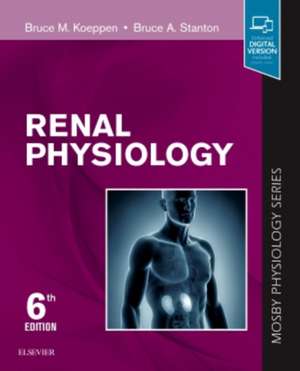Renal Physiology: Mosby Physiology Series: Mosby's Physiology Monograph
Autor Bruce M. Koeppen, Bruce A. Stantonen Limba Engleză Paperback – 24 noi 2018
Preț: 202.03 lei
Preț vechi: 277.92 lei
-27% Nou
38.66€ • 41.34$ • 32.23£
Carte disponibilă
Livrare economică 20 martie-03 aprilie
Livrare express 13-19 martie pentru 96.08 lei
Specificații
ISBN-10: 0323595685
Pagini: 248
Ilustrații: 91 illustrations (91 in full color)
Dimensiuni: 191 x 235 x 12 mm
Greutate: 0.46 kg
Ediția:6
Editura: Elsevier
Seria Mosby's Physiology Monograph
Cuprins
INTRODUCTION
CHAPTER 1
PHYSIOLOGY OF BODY FLUIDS
Objectives
Concept of Steady-State Balance
Physicochemical Properties of Electrolyte Solutions
Molarity and Equivalence
Osmosis and Osmotic Pressure
Osmolarity and Osmolality
Tonicity
Oncotic Pressure
Specific Gravity
Volumes of Body Fluid Compartments
Composition of Body Fluid Compartments
Fluid Exchange between Body Fluid Compartments
Capillary Fluid Exchange
Cellular Fluid Exchange
Summary
Key Words and Concepts
Self-Study Problems
CHAPTER 2
STRUCTURE AND FUNCTION OF THE KIDNEYS
Objectives
Structure of the Kidneys
Gross Anatomy
Ultrastructure of the Nephron
Ultrastructure of the Glomerulus
Ultrastructure of the Juxtaglomerular Apparatus
Innervation of the Kidneys
Summary
Key Words and Concepts
Self-Study Problems
CHAPTER 3
GLOMERULAR FILTRATION AND RENAL BLOOD FLOW
Objectives
Renal Clearance
Glomerular Filtration Rate
Glomerular Filtration
Determinants of Ultrafiltrate Composition
Dynamics of Ultrafiltration
Renal Blood Flow
Regulation of Renal Blood Flow and Glomerular Filtration Rate
Sympathetic Nerves
Angiotensin II
Prostaglandins
Nitric Oxide
Endothelin
Bradykinin
Adenosine
Natriuretic Peptides
Adenosine Triphosphate
Glucocorticoids
Histamine
Dopamine
Summary
Key Words and Concepts
Self-Study Problems
CHAPTER 4
RENAL TRANSPORT MECHANISMS: NaCl AND WATER ABSORPTION ALONG THE NEPHRON
Objectives
General Principles of Membrane Transport
General Principles of Transepithelial Solute and Water Transport
NaCl, Solute, and Water Reabsorption Along the Nephron
Proximal Tubule
Henle's Loop
Distal Tubule and Collecting Duct
Regulation of NaCl and Water Reabsorption
Summary
Key Words and Concepts
Self-Study Problems
CHAPTER 5
REGULATION OF BODY FLUID OSMOLALITY: REGULATION OF WATER BALANCE
Objectives
Arginine Vasopressin
Osmotic Control of Arginine Vasopressin Secretion
Hemodynamic Control of Arginine Vasopressin Secretion
Arginine Vasopressin Actions on the Kidneys
Thirst
Renal Mechanisms for Dilution and Concentration of the Urine
Medullary Interstitium
Vasa Recta Function
Assessment of Renal Diluting and Concentrating Ability
Summary
Key Words and Concepts
Self-Study Problems
CHAPTER 6
REGULATION OF EXTRACELLULAR FLUID VOLUME AND NaCl BALANCE
Objectives
Whole-Body Na+ Balance
Concept of Effective Circulating Volume
Volume-Sensing Systems
Volume Sensors in the Low-Pressure Cardiopulmonary Circuit
Volume Sensors in the High-Pressure Arterial Circuit
Volume Sensor Signals
Renal Sympathetic Nerves
Renin-Angiotensin-Aldosterone System
Natriuretic Peptides
Arginine Vasopressin
Control of Renal NaCl Excretion During Euvolemia
Mechanisms for Maintaining Constant Na+ Delivery to the Distal Tubule in Euvolemia
Regulation of Distal Tubule and Collecting Duct Na+ Reabsorption in Euvolemia
Control of Na+ Excretion with Volume Expansion
Control of Na+ Excretion with Volume Contraction
Edema
Alterations in Starling Forces
Capillary Hydrostatic Pressure (Pc)
Plasma Oncotic Pressure (?c)
Lymphatic Obstruction
Capillary Permeability
Role of the Kidneys
Summary
Key Words and Concepts
Self-Study Problems
CHAPTER 7
REGULATION OF POTASSIUM BALANCE
Objectives
Overview of K+ Homeostasis
Regulation of Plasma [K+]
Epinephrine
Insulin
Aldosterone
Alterations of Plasma [K+]
Acid-Base Balance
Plasma Osmolality
Cell Lysis
Exercise
K+ Excretion by the Kidneys
Cellular Mechanisms of K+ Transport by Principal Cells and Intercalated Cells in the Distal Tubule and Collecting Duct
Regulation of K+ Secretion by the Distal Tubule and Collecting Duct
Plasma [K+]
Aldosterone
Arginine Vasopressin
Factors that Perturb K+ Excretion
Flow of Tubular Fluid
Acid-Base Balance
Glucocorticoids
Summary
Key Words and Concepts
Self-Study Problems
CHAPTER 8
REGULATION OF ACID-BASE BALANCE
Objectives
?Buffer System
Overview of Acid-Base Balance
Renal Net Acid Excretion
?Reabsorption Along the Nephron
Regulation of H+ Secretion
Formation of New
Response to Acid-Base Disorders
Extracellular and Intracellular Buffers
Respiratory Compensation
Renal Compensation
Simple Acid-Base Disorders
Metabolic Acidosis
Metabolic Alkalosis
Respiratory Acidosis
Respiratory Alkalosis
Analysis of Acid-Base Disorders
Summary
Key Words and Concepts
Self-Study Problems
CHAPTER 9
REGULATION OF CALCIUM AND PHOSPHATE HOMEOSTASIS
Objectives
Calcium
Overview of Ca++ Homeostasis
Ca++ Transport Along the Nephron
Regulation of Urinary Ca++ Excretion
Calcium-Sensing Receptor
Phosphate
Overview of Pi Homeostasis
Pi Transport Along the Nephron
Regulation of Urinary Pi Excretion
Integrative Review of Parathyroid Hormone and Calcitriol on Ca++ and Pi Homeostasis
Summary
Key Words and Concepts
Self-Study Problems
CHAPTER 10
PHYSIOLOGY OF DIURETIC ACTION
Objectives
General Principles of Diuretic Action
Sites of Action of Diuretics
Response of Other Nephron Segments
Adequate Delivery of Diuretics to Their Site of Action
Volume of the Extracellular Fluid
Diuretic Braking Phenomenon
Mechanisms of Action of Diuretics
Osmotic Diuretics
Carbonic Anhydrase Inhibitors
Loop Diuretics
Thiazide Diuretics
K+-Sparing Diuretics
Aquaretics
Effect of Diuretics on the Excretion of Water and Other Solutes
Solute-Free Water
K+ Excretion
HCO?Excretion
Ca++ and Pi Excretion
Summary
Key Words and Concepts
Self-Study Problems
ADDITIONAL READING
A P P E N D I X A INTEGRATIVE CASE STUDIES
A P P E N D I X B NORMAL LABORATORY VALUES
A P P E N D I X C NEPHRON FUNCTION
A P P E N D I X D ANSWERS TO SELF-STUDY PROBLEMS
A P P E N D I X E ANSWERS TO INTEGRATIVE CASE STUDIES
A P P E N D I X F REVIEW EXAMINATION
APPENDIX G ANSWERS TO REVIEW EXAMINATION
INDEX
Descriere
Gain a foundational understanding of renal physiology and how the renal system functions in health and disease. Renal Physiology, a volume in the Mosby Physiology Series, explains the fundamentals of this complex subject in a clear and concise manner, while helping you bridge the gap between normal kidney function and disease with pathophysiology content throughout the book.

















